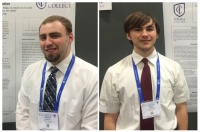 Chemistry majors Jameson T. Martin ('16) and Joshua M. Speer ('17) presented their research during the ACS Undergraduate Research Poster session at the ACS National Meeting on March 14th.
Chemistry majors Jameson T. Martin ('16) and Joshua M. Speer ('17) presented their research during the ACS Undergraduate Research Poster session at the ACS National Meeting on March 14th. 
Jameson Martin: Ternary transition metal nitrides through ammonolysis: synthesis and characterization
Abstract: Binary transition metal nitrides exhibit some favorable properties such as hardness, electrical conductivity, and temperature stability. Ternary metal nitrides exhibit more favorable or multiple variations of these properties based on the extended chemical structure. Ternary nitrides can be synthesized by ammonolysis of their subsequent ternary oxides. Ternary metal oxide powders exhibit the general formula of BaxMyOz (where M is a transition metal), such as BaFe2O4 and BaCrO4. These compounds are synthesized by the stoichiometric mixture of binary metal oxide powders heated to 800°-1000°C for several days. The resulting powders are heated under the flow of ammonia to exchange the oxygen for nitrogen. The products were characterized with powder X-ray diffraction and single crystal diffraction.
Joshua Speer: Comparative synthesis between the glycine-nitrate process and facile co-precipitation of La- and Ce-based perovskites
Abstract: Compounds with the perovskite structure have a variety of chemical and physical properties, for example, catalytic oxidation of toxic waste products and conversion of CO2 and H2 into methanol for fuel. However, perovskite synthesis can be challenging, so two different synthetic methods were compared: the glycine-nitrate process and facile co-precipitation. Perovskite structures of the type ABO3 were investigated where A is La, Ce, or Y and B is Fe, Mn, Al, Y, Ca, Sr, Ba, Cu, or Zn. Neither method was found to be superior to the other for all reactions; the glycine nitrate process was superior for LaFeO3, LaMnO3, and CeBaO3 forming very little side product (if any) while co-precipitation led to significant side product formation of La(OH)3 or CeO2. The co-precipitation method was superior for CeFeO3 and CeZnO3 forming the main product when the glycine nitrate process only formed a mixture of binary oxides.
With over 158,000 members, the American Chemical Society is the largest scientific society in the world. Each year the Department of Chemistry sends exceptional student researchers to an ACS national meeting. Students consistently rank this trip as one of the most significant learning experiences during their time at Ithaca College.
Joshua's research and trip to ACS was funded in part through the Jean Dreyfus Boissevain Lectureship Award, received by Dr. Mike Haaf on behalf of the Department of Chemistry. This grant supports accomplished young faculty, develops leadership in environmental chemistry, supports undergraduate research and emeritus faculty, and funds lectureships at primarily undergraduate institutions.
https://www.ithaca.edu/intercom/article.php/20160328142044464